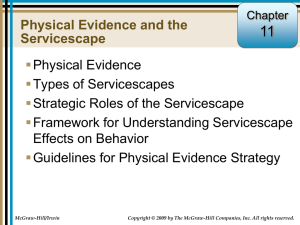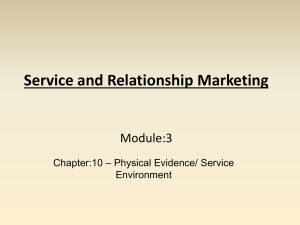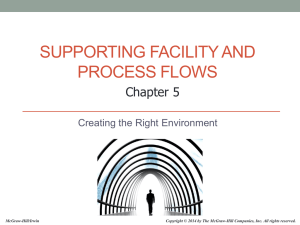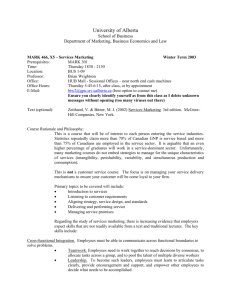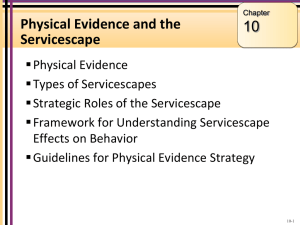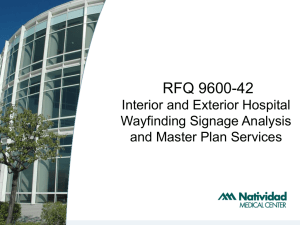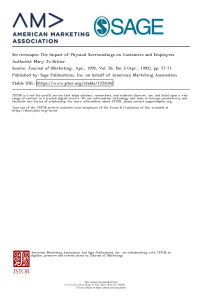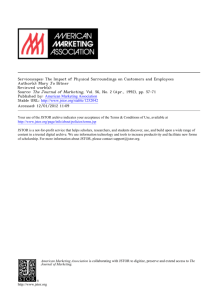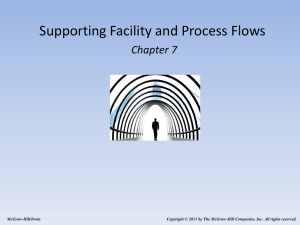Chapter 8 - Goodfellow Publishers
advertisement
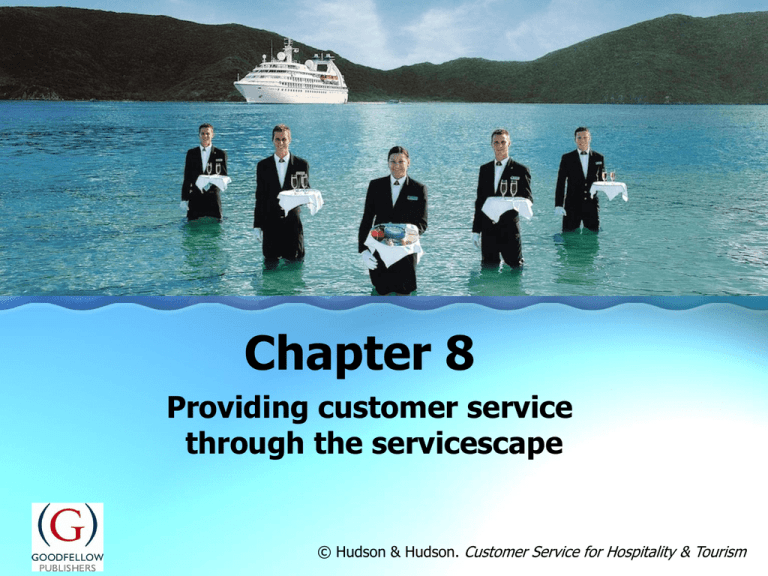
Chapter 8 Providing customer service through the servicescape © Hudson & Hudson. Customer Service for Hospitality & Tourism Topics Covered o Elements of the servicescape o The strategic role of the servicescape o Developing servicescapes o The effects of servicescapes on consumer behaviour o Waiting line strategies ‘At Your Service’ Spotlight: Hospitality Starbucks-style ‘Third place’ - a social, yet personal environment ….where people connect with others and reconnect with themselves. o Themes inspired by Italian espresso bars • Inviting, comfortable, compelling servicescapes • Sensory pleasures and ambiance • Italian terminology o Customer focused • First names on paper cups • Free WiFi for work, social networking • Meeting place, community hub o Long-term brand integrity • Espresso machines replaced • Modified menu items • Slowed expansion, new products Key characteristics of the servicescape o Physical facility referred to as the ‘servicescape’ • Facilitates performance or communication of service o Physical environment or service arena • Service delivery • Firm and customers interactions o Customer assessment of intangible services • Physical evidence • Tangible cues and components Elements of the servicescape Facility Exterior Parking Landscape Signage Exterior design Table 8.1 Facility Interior Layout Equipment Signage Air temperature Interior design Lighting Other Tangibles Uniforms Business cards Stationary Invoices Brochures Web pages Employee dress The strategic role of the servicescape o Packaging • Creates external image • Sets expectations o Facilitator • Aids performances of service providers • Physical layout and functional design o Socializer • Suggests expected roles, behaviors and relationships o Differentiator • Distinguished from competitors • Signals appropriate market segments Developing servicescapes o Effective servicescapes include: • Holistic designs • Complementary e.g. arousal elements • Service products match design elements o Themed servicescapes o Interactive servicescapes o Servicescapes developed around new market segments Snapshot: Incheon Airport, Korea First and last impressions. o Customer transit services • Fast processing times, interactive LCD info screen • Multi-lingual staff and signage o Customer amenities • Free internet access, computers, showers, changing rooms • Between flight tours, golf outings • Shops, food courts, lounges, cultural centers o Staff training and improvement • ICAO training center • Service Improvement Committee • Incentive program o Technological innovations • Cooperation and data sharing • Passenger number forecasting The effects of servicescapes on consumer behaviour o Customers loyalty incentives: • High perceived value • ‘Get’ should exceed ‘Give’ • Rewards for loyalty o Company benefits: • Higher profits through retaining customers ⁻ More purchases overall ⁻ More frequent purchases • Lowers operating costs ⁻ No acquisition costs • Increases company referrals How the servicescape impacts consumers and employees Environmental Dimensions Ambient Conditions Behavioral responses Music Temperature Air quality Noise Smell Color Spatial layout and functionality Spatial layout Floor plan Size Shape of Furnishings Counters Equipment Arrangement Moderators Internal Response Employee Both Employees and Customers Affiliation Exploration Cognitive Responses Holistic Environment Perceived Servicescape Functionality Ability to facilitate the performance of service transactions Signs, Symbols & Artifacts Signage Personal artifacts Style of décor Staff and guests Behavior Image Figure 8.1 (Source: Adapted from Bitner, 2002) Employee Response Moderators Beliefs (about place, people and products) Categorization Symbolic meaning Emotional Response Customer Response Moderators Mood (The Russell model of affect ) Attitude Stay longer Commitment Carry out plan Social Interaction between and among customers and employees Avoid opposite Customer Attraction Physiological responses Exploration Stay longer Comfort Shiver Pain Dizzy Continue purchasing Carry out plan Return Spread word of mouth Avoid opposite Common associations and human responses to colors Color Red Degree of warmth Warm Orange Warmest Yellow Warm Green Blue Cool Coolest Indigo Violet Cool Cool Common associations and human responses High energy and passion; can excite, stimulate, and increase arousal levels and blood pressure Emotions, expression and warmth; noted for its ability to encourage verbal expressions of emotions Optimism, clarity, and intellect; bright yellow often noted for its mood-enhancing ability Nurturing, healing, and unconditional love Relaxation, serenity, and loyalty; lowers blood pressure; is a healing color for nervous disorders and for relieving headaches, because of its cooling and calming nature Meditation and spirituality Spirituality; reduces stress and can create an inner feeling of calm Table 8.2 (Source: Based on Lovelock and Wirtz, 2007) Waiting line strategies o Employ operational logic • Streamline operational processes • Eliminate inefficiencies • Queue configuration o Establish a reservation system • Shift demand to time less busy periods • Inherent problem of ‘no-shows’ ⁻ Charge fee ⁻ Overbook capacity o Differentiate waiting customers • Need-based or customer priority • Guest registering e.g. FASTPASS The psychology of waiting lines Table 8.3 (Source: Maister, 1985) Case Study: Attention to Detail at Cavas Wine Lodge We seek the best experience, effortless for our guests. o Exterior design complements landscape o Interior design: • Unique décor, color schemes • Mood enhancing music, atmospheric lighting, “clean and fresh” smell • Hand-selected objects, furniture by local craftsmen, artists • Regional, organic fruit and vegetables o Customer service • Staff uniforms • Frontline service • Guest expectations • Surprise events e.g. tango evenings outdoor cooking lessons
